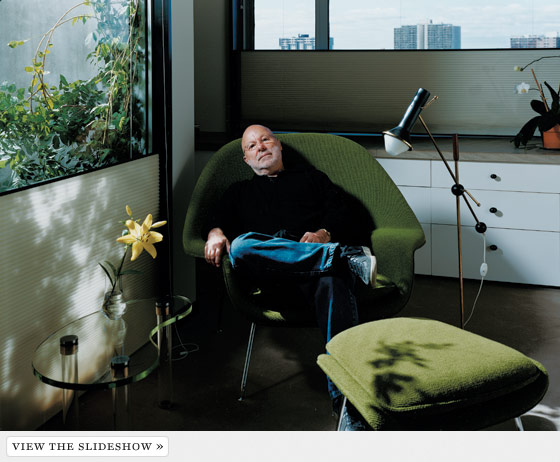
Photograph by Mark Heithoff
Glossy white walls adorned with little more than an occasional black-and-white photograph. Built-in plywood platforms covered in charcoal-gray industrial carpeting and decked out with pillows. Track lighting on the ceiling, black rubber Pirelli tile on the floor, white vertical blinds rustling in the windows. And a mechanically rotating cleaner’s rack in the closet.
This was the mid-seventies, when the industrial, high-tech look was ascendant and Joe D’Urso was its chrome-plated agent. One of his first projects, a cool, gleaming studio apartment for 19-year-old shoe-store heir Reed Evins, landed on the cover of Interior Design and got him Calvin Klein as a client. “It was the first really minimalist space,” says D’Urso, who’d just quit working with modernist Ward Bennett to strike out on his own.
There were those long, low platforms (“Everyone hung out on the floor,” recalls D’Urso), vertical blinds to hide the bed, a Corbusier chaise, a long table with a stainless-steel edge and a reflective black rubber top, and a metal meat-market door leading into the kitchen.
Everyone who saw it wanted to throw out everything they had and hire D’Urso. Wire-and-glass coffee tables, hospital-curtain tracks, restaurant stoves, exposed ductwork, doctors’ sinks, security mirrors, marine hardware, gym lockers, and cyclone fencing: Those were the materials that D’Urso brought into the New York living space called the loft.
Back then, D’Urso explains, “Everything was fake wood, appliances were hideous, and there was little to work with in terms of products and furniture.” So he looked for things that were more engineered than styled. “If you wanted to put flowers in a vase, you had a choice between a clunky Steuben vase or a piece of laboratory glass. It was a way of thinking more about functionality instead of sentimentality.”
Now 64, D’Urso is proud of his trailblazing but reluctant to be pigeonholed as Joe High-Tech. He’s a passionate fan of color, which he keeps in tightly focused spots, and he likes vintage design that’s not chrome-plated, from Charles Rennie Macintosh to Florence Knoll to French ceramics from the fifties by artists like Roger Capron.
D’Urso’s life is less hectic now, and he’s somewhat of a recluse, more likely to dodge a phone call than take it—a far cry from the early eighties, when he had clients like the mammoth sportswear company Esprit (he did its Los Angeles corporate showroom). The projects he still takes on, like the New Jersey waterfront apartment shown here, have the hallmarks of his early passions. He still likes everything low to the ground, plain but luxurious, and inclusive despite its minimalist airs. This is a man whose idea of beauty can be equally satisfied by a pristine black-tiled bathroom or a massive blooming geranium plant.
“I put it together like a collage,” he swears. “I don’t have any preconceived ideas.”
Profession: Interior Designer
Peak: 1970 to 1985
Essential Design: Chrome Table

(Photo: Courtesy of Low Studio)
1978 Joe D’Urso, in the seminal chrome-and-platform apartment he designed for Reed Evins three years earlier. Photograph by Peter Aaron/ Esto